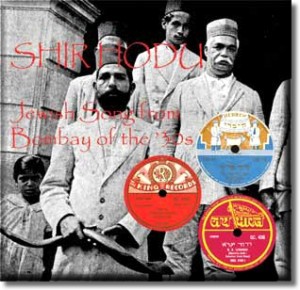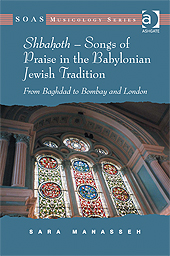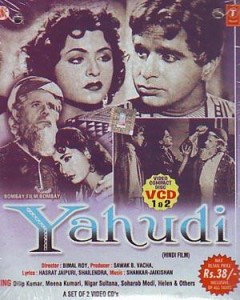A version of this piece first appeared in Time Out Mumbai.
The dulcet ring of the oud is impossible to miss on the soundtrack of Yahudi, Bimal Roy’s unlikely Bollywood historical made in 1958 about the persecution of Jews in ancient Rome. The background score, composed by Shankar and Jaikishan, has a vaguely Middle Eastern feel to it and as the plot twists and turns, it often falls to the versatile Arabian stringed instrument to signal the swirling emotions. As massacres are ordered, betrayals ensue and Dilip Kumar falls in love with Meena Kumari, the oud sobs, sighs and sings to enhance the mood on screen. It could easily have descended into kitsch. Perhaps the reason it didn’t was the fact that the man plucking the strings, Isaac David, was well acquainted with Middle Eastern music. David was Jewish himself and in the early years of the last century, he had polished his art by playing with an ensemble in Mumbai that recorded four discs of Iraqi Jewish tunes for the Hebrew Record label.
 Some of those tunes can be heard on a collection called Shir Hodu: Jewish Song from Bombay of the ’30s, which offers a fascinating reminder of the city’s cosmopolitan heritage. The 15 archival tracks on the album have been painstakingly put together by Sara Manasseh, a Bombay-born Iraqi Jewish ethnomusicologist who now lives in London. During the 1930s, Bombay was “a musical kaleidoscope”, Manasseh says in her liner notes, and the pieces included music and Jewish prayer chants in Hebrew.
Some of those tunes can be heard on a collection called Shir Hodu: Jewish Song from Bombay of the ’30s, which offers a fascinating reminder of the city’s cosmopolitan heritage. The 15 archival tracks on the album have been painstakingly put together by Sara Manasseh, a Bombay-born Iraqi Jewish ethnomusicologist who now lives in London. During the 1930s, Bombay was “a musical kaleidoscope”, Manasseh says in her liner notes, and the pieces included music and Jewish prayer chants in Hebrew.
Last year, Manasseh explained the historical and theoretical context of this music in a book titled Shbahoth – Songs of Praise in the Babylonian Jewish Tradition: From Baghdad to Bombay to London.
Bombay has long been home to three distinct Jewish groups. The largest is the Bene Israel, who believe that their ancestors were shipwrecked off the Alibaug coast in 175 BCE. From the nineteenth century, Iraqi Jewish traders – Manasseh’s ancestors – fleeing religious persecution began to settle in Bombay. This group came to be known as the Baghdadis. In the 1930s, a small number of Jews from Kochi, whose ancestors had arrived in Kerala in the tenth century BCE, also lived in Bombay.
 Both the Bene Israel and the Baghdadis had vibrant musical traditions in the 1930s. The Bene Israeli repertoire was in Marathi, drawing its themes from the Psalms and other Biblical sources. Among the prominent community musicians was Nathan Solomon Satamkar, a dashing silent movie actor whose family established two musical schools to provide instruction in such instruments as the sitar and the dilruba, Manasseh said.
Both the Bene Israel and the Baghdadis had vibrant musical traditions in the 1930s. The Bene Israeli repertoire was in Marathi, drawing its themes from the Psalms and other Biblical sources. Among the prominent community musicians was Nathan Solomon Satamkar, a dashing silent movie actor whose family established two musical schools to provide instruction in such instruments as the sitar and the dilruba, Manasseh said.
To Bombay ears, the music of the Baghdadis must have seemed far more exotic. Shir Hodu includes tracks by Silman Museri, whose group included “dancing girls who would balance candelabras on their heads”, Manasseh said in an email interview. Also popular was Mnashi Abu Moshe, a blind singer who sometimes entertained at parties thrown by Manasseh’s grandparents. “He would sing popular Arabic songs from Baghdad, and also improvise songs…about people who were at the party,” Manasseh said. “My grandmother would sit by him and tell him who was there.”
Soon, some of these Jewish tunes made their way into mainstream Bombay culture. Among these was Habibi, which became “Jata Kahaan Hai Diwaane” in the 1956 film CID. (Listen here). “It was introduced by the Maimon brothers, who came to India from Palestine and taught it to friends in Bombay,” Manasseh said. “One of the sisters in the Ma’atuk family, a Jewish family in Byculla, sang it to the music director, OP Nayyar, who adapted it.” The tune is part of the repertoire of the Rivers of Babylon, the group Manasseh has put together in London to perform Baghdadi Jewish music.
 Bombay’s Jews also made themselves heard on movie soundtracks. Isaac David, whose oud enlivened Yahudi, also played the qanun (a Middle Eastern zither), mandolin and guitar in the film studios. David had been taught by Faizulla Taghioff, a dealer in precious stones who came to Bombay from Samarkhand. Taghioff can be heard on many tracks on Shir Hodu. He also played the mandolin in many films, including Awaara and Mera Naam Joker, performing under the stage name Abdul Rahim Taghioff.
Bombay’s Jews also made themselves heard on movie soundtracks. Isaac David, whose oud enlivened Yahudi, also played the qanun (a Middle Eastern zither), mandolin and guitar in the film studios. David had been taught by Faizulla Taghioff, a dealer in precious stones who came to Bombay from Samarkhand. Taghioff can be heard on many tracks on Shir Hodu. He also played the mandolin in many films, including Awaara and Mera Naam Joker, performing under the stage name Abdul Rahim Taghioff.
To Manasseh, the songs on Shir Hodu carry a melodious message about the character of the Baghdadis – and about Bombay. “This illustrates the great love for music, their inherent joie de vivre,” Manasseh said. “The Baghdadians were very much part of the surrounding society. Bombay (and Mumbai today) being such a cosmopolitan city, Baghdadians were soon very much at home with all, whoever they met.” Manasseh added: “That is the wonderful thing about Bombay/Mumbai – everyone is different, and so everyone is the same. There was no artificial “tolerance” of the “other”. We were all the “other” and therefore all the same.”
You can buy Shir Hodu here and read more about Manasseh on her website here.
Here’s a performance by Manasseh’s group, Rivers of Babylon.


4 comments
Sir David and Albert Sassoon who did so much for Bombay and Pune were Baghdadi Jews Bombayites and Puneites today enjoy the benefits of their generosity The community in Kihim across the Bay also had a comprises a signifcant number of Jewish people who are the descendants of those who found their way there
Can someone explain to me how the phrase “Hava nagila” made it into this song?
Jeetendra & Kimi Katkar, “Kase Raho Mujhe Bahon Mein” (Mulzim, 1988)
Very interesting piece .Thanks .
Very interesting info .Thanks for sharing .This film Bimal Roy directed to help the producer who was completely broke .